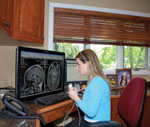
Elizabeth Maltin, M.D., a neuroradiologist with Zwanger Presiri Radiology, has worked from her home office for nearly a year using a Merge Fusion RIS/PACS workstation that replicates the system used by office-based radiologists.
As managed care penetrated more fully into the radiology sector in the 1990s, the industry experienced a time in which demand for diagnostic radiology exceeded the supply of radiologists. Studies published in the early part of this decade highlighted a severe radiologist shortage.
Change in Demand
Recent research, however, suggests a shift. The study “Who’s Underworked and Who’s Overworked Now? An Update on Radiologist Shortage and Surplus,” published in the March 2010 issue of the American Journal of Roentgenology, indicates the radiology shortage may have abated. Researchers found the overall balance of radiologists shifted toward a slight surplus between 2003 and 2007.
“The employment market seems generally, but not universally, to self-correct relative shortages and surpluses in individual geographic areas and subspecialties within a few years,” the authors concluded.
The impact of technology on trends in radiologist supply and demand is an important factor. The adoption of picture archive and communication systems (PACS), voice recognition, and teleradiology solutions has dramatically increased radiologist productivity. With advances in digital imaging technology, increasing numbers of radiologists are moving into subspecialty areas.
As consumers age, the radiology sector is feeling another shift. Utilization data concludes older adults use imaging services three times more often than younger people. By 2020, the national population is projected to be 325 million, with a 50 percent increase of people age 65 and older.
Based on these trends and on the ever-changing reimbursement landscape, radiology practices must maintain focus on recruitment and retention.
Recruitment and Retention Strategies
Recruiting excellent radiologists may be the most vital component to a successful radiology practice, but it is not the only one. Front and back office staff, technologists and administrators all play key roles in making or breaking an organization. Replacing staff due to turnover can be difficult and is often is costly and disruptive.
Today’s organizations use various recruitment and retention strategies. As the CIO of a multisite, outpatient imaging center, I was recently challenged to explore how information technology (IT) could be used to support recruitment and retention.
Our organization has grown steadily since 1953. Today, we provide x-ray, magnetic resonance imaging (MRI), computed tomography (CT), nuclear medicine, ultrasound, mammography, and dual energy x-ray absorptiometry bone densitometry.
RIS/PACS Integration
IT played a critical role in helping us optimize efficiency to support growth. In 1993, we were an early adopter of radiology information systems (RIS), and one year later we added a PACS. Initially, each of our offices had its own server and database. Soon, this model presented challenges, and we moved to a fully integrated RIS/PACS.
In 2004, we adopted the Fusion RIS/PACS from Merge Healthcare. With this blended system, we continued to use our established RIS-driven workflow model, while using our new infrastructure to increase productivity across multiple locations.
With our enterprise-class information and image management solution, we fully integrated our workflow across office staff, technologists, clinicians, radiologists, transcriptionists, billing, and referring physicians. We also moved to a distributed model, in which our specialty radiologists could stay in place rather than traveling to various clinics.
Radiologists Set up Shop at Home
In 2007, one of our key radiologists shared plans to resign to stay at home with her children. We explored options for her to continue working and installed an Internet-connected reading station in her home. Establishing a home-based work environment for a radiologist is vastly different from doing so for a transcriptionist. Physicians require more sophisticated hardware and software. Connectivity plays a significant role based upon image size, data volume and speed of transfer.
To ensure quality and consistency, this home-based workstation replicates our office-based reading stations. We’ve upgraded our network to accommodate her capacity to read larger studies. She now works for us on a variable schedule and performs reads when our offices are closed.
We retained a nuclear medicine scheduler by allowing her to work from home. She can schedule the nuclear exams that are familiar to her as well as other exams.
Last summer, one of our neuroradiologists informed us his wife secured a prestigious position on the west coast and he planned to move. He assumed he would need to seek new employment, but we thought otherwise. We organized a home-based office, using an information technology (IT) resource in his city. Today, based upon time zone differences, he readily covers our late hours.
Recently, we sought to establish home offices for mammographers in both New York City and in California. Empowering radiologists to read breast studies from home presented additional challenges based upon image size, prior exam access/workflow and workstation certification requirements. We identified solutions and now employ these two home-based mammographers.
Our IT-driven recruitment and retention initiatives have required an investment. In the case of radiologists, this can total thousands of dollars per workstation in addition to costs for remote IT support and on-site monitoring of quality assurance. We’ve had to make revisions to our workflow, and we’ve needed to increase network bandwidth to the Internet. But, our investment has paid off.
When developing recruitment and retention strategies, home-based officing sweetens the offer when recruiting and retaining top radiologists.
The Newly Integrated System Enables Users to:
- Centralize scheduling for customer service
- Automate tasks to reduce rework and minimize errors
- Streamline identification of and attention to stat cases
- View images (including priors) and associated documentation, while doing the review
- Review and proof reports and provide a digital signature via a to-be-signed screen
- Automatically fax reports upon signing and autobatch reports for printing/mailing
- Add a Web-based referring practice portal to expedite report delivery
- Move data to billing and autorouting to coders for checking
- Procure data and display prefetching and autorouting functions
About the Author: Matt Dewey is the CIO at Zwanger-Pesiri Radiology, an outpatient medical imaging services provider with more than 40 radiologists in eight locations across Long Island, N.Y.


 December 01, 2025
December 01, 2025 









